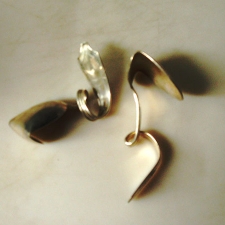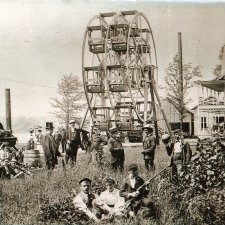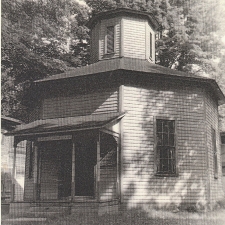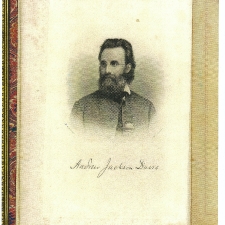



Johann Carl Friedrich Zollner, Professor of Physical Astronomy at the University of Leipzig died on the morning of April 25, 1882 of a hemorrhage of the brain. He was forty-eight years old, of sound mind and the best of health. Professor Zollner was an ardent believer in spiritualism and wrote the book Transcendental Physics. He had the moral courage to place in print what he felt in his heart and mind, and then was severely criticized. The Atlantic Monthly, September 1881 is one example. Not only was Professor Zollner ridiculed, the article included William Crookes, F.R.S., the discoverer of the radiometer, and the author of a brilliant paper on Radiant Matter; William Edward Weber, Professor of Physics, and one of the first authorities in the subject of electricity and magnetism; Professor Scheibner, of Leipzig, a mathematician; Gustave Theodore Fechner, Professor of Physics at Leipzig; and Lord Lindsay, of Astronomical fame. These scientists were converts to spiritualism because they had tested, seen and witnessed with their own eyes the marvels of spiritualism.
Jack Kelly, Mr. Vosburgh, Mae West—dedication of Healing Temple Lily Dale.
A personal recollection of events concerning the origin and erection of the Healing Temple. By Robert Zagora [step son of Rev. Jack Kelly]
Early in the 1950’s Rev. Kelly’s spirit teachers advised us that they were working to add healing to the Trance and Independent voice phases of Mediumship usually displayed publicly, while the medium was reading sealed billets. Early in the season of 1953 an incident occurred which perhaps more than anything else became the genesis of the Healing Temple. After completing a message service at the Auditorium, Rev. Kelly walked out the back door with my mother by her side. He was approached by a lady wearing sunglasses, walking on the arm of her husband while using a cane in the other hand. She said, “I did so want a message today but did not receive one.” As Rev. Kelly was about to give his stock answer, “ I’m sorry but once out of trance I can’t tell you a thing” His spirit Teacher, who could be heard speaking through the solar plexus of the medium interrupted to say, “Have her sit down, we want to work on her eyes.” She did as she was directed, sitting on a bench outside the Auditorium, where Rev. Kelly worked on her eyes and after a few minutes she exclaimed that her sight was returning. (Some weeks later we were able to question one of the Rev. Kelly’s spirit teachers in class concerning this incident and the teacher told us, “We were able to discern that there was a break in the optic nerve and by concentrating the healing power at that point, fuse the break together.”) Needless to say this caused quite a furor among people in the area who witnessed the healing.
One of those who took notice was Louis T. Vosburgh, who operated a bookstore on the present site of the Lily Dale offices and served as Lily Dale president in 1955. He spoke at length about his belief that there should be a special temple set aside to accommodate the highest form of mediumship. While Mr. Vosburgh started making plans for the erection of the Healing Temple, Rev. Kelly held healing services at the Auditorium on Sunday evenings in 1953 and 1954. Further questioning of the woman whose sight was restored elicited the information that she had lost about 90% of her sight after being involved in an auto accident in which her head hit the windshield. The prognosis from doctors just before her healing was it was not certain that her sight would return.
Mr. Vosburgh acted as his own contractor and using subcontractors supervised the erection of the Healing Temple, to the best of my knowledge with his own money. (Between 25 and 30 thousand dollars) It was erected for Rev. Kelly’s exclusive use and dedicated on July 3, 1955, but after 1957 Mr. Vosburgh turned it over to the Dale Assembly. Ironically, Mr. Vosburgh erected the Healing Temple (the only public building erected in the Dale in the last 66 years) not only without the aid of the Dale Assembly but almost in spite for the lack of knowledge concerning its origin. The Temple remains largely the same today except for the addition of an organ and the paneling in the Temple itself. Since Mr. Vosburgh had the foresight to add a heating system to the building he not only left the Dale a heated Temple, but a church building used all year round.
The first form of slate writing was produced on two 5”x7” clean school size slates, placed side by each. A “school slate” was first used during the days of the one room schoolhouse, paper was expensive and in short supply and the children would each hold a small slate on which to write, after which the lesson could easily be erased, thus no paper would be wasted. A small piece of slate pencil was placed on one side of the slates; the slates were fastened together on top of each other. As the years passed by and the small school sized slates were more difficult to find a similar sized box was made that could also be securely fastened together; except a 5”x7” index card was placed in the enclosed area with a lead pencil tip broken off and placed within the enclosed box.
During the second half of the 19th century and early 20th century, pencils cut from solid pieces of soap stone were used by school children for use in the class room to write on 5”x7” tablets cut from the harder grades of slate. Slate pencils were available with the slate core unwrapped, wrapped in paper or encased in wood. Slate pencils were advertised as late as 1914, wood cased slate pencils were still sold as late as the early 1930’s but were difficult to obtain. The chalk used today, (black board chalk), which is used on the large schoolroom black boards is made from calcium sulfate and is primarily of plant origin.
Houdini returned to NYC in the summer of 1910-boarded a train to cross New York State to the tiny community of Mayville in Chautauqua County. The 2-day train trip was for the specific reason of visiting Ira Davenport—considered an elder statesman of the Spiritualist movement. A tiny stoop shouldered man with a walrus mustache met Houdini at the station in Mayville. Ira, weakened from throat cancer displayed none of his mysterious intensity that captivated audiences around the World.
At Ira’s house he was anxious to talk about the good old days and explain his part in all the controversies and explain his secret of the spirit cabinet. Davenport charmed the young escape artist Houdini. Davenport picked up a cord of rope, moved his chair close to Houdini and smiled—Houdini realized he was now watching history. Houdini’s notebook was at the ready.
Davenport opened his wrists to display the proper way to catch an extra loop of rope and the way of putting his hands behind his back and then tied-enough slack in the rope to slip out.
When Houdini departed he never bothered to travel the extra 20 miles to Lily Dale-the largest community of mediums in the United States. Houdini was not at war with the Spiritualists—that would be a few more years.
 (54)
(54)
 (3)
(3)